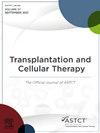Risk-Adapted Letermovir Prophylaxis Based on a Scoring System Predicting a Higher Burden of Cytomegalovirus Exposure After Allogeneic Hematopoietic Cell Transplantation
IF 3.6
3区 医学
Q2 HEMATOLOGY
引用次数: 0
Abstract
We previously reported that the area under the curve of log-transformed cytomegalovirus antigenemia (CMV-AUC) until 100 days after allogeneic hematopoietic cell transplantation (allo-HCT) was associated with an increased risk of non-relapse mortality. We applied a risk-adapted letermovir (LTV) prophylaxis strategy guided by a risk score that predicts a higher CMV-AUC. First, we retrospectively analyzed 278 allo-HCT recipients between 2007 and 2017 (Period 1). We scored risk factors for higher CMV-AUC by odds ratios: malignant lymphoma including adult T cell leukemia/lymphoma (1 point), an unrelated or haploidentical donor (1 point), and recipient/donor CMV serostatus (+/+; 2 points, +/-; 3 points). We have administered LTV to patients with a total score of ≥ 4 points. We then focused on 143 patients who underwent allo-HCT when we applied this strategy (Period 2). Forty patients (28%) in Period 2 received LTV prophylaxis. Two patients (5.4%) exhibited higher CMV-AUC among 37 patients in the higher-risk group (≥ 4 points). However, as many as 33% of the patients with 3 points in Period 2 experienced higher CMV-AUC. Notably, in the lower-risk patients of Period 2, 68% of patients who received systemic steroids for acute graft-versus-host-disease (GVHD) developed higher CMV-AUC. Our risk-adapted LTV prophylaxis strategy effectively prevented higher CMV-AUC in the higher-risk group and reduced the use of LTV. Additionally, including the use of systemic steroids for acute GVHD in this risk-adapted approach is preferable.
基于预测异基因造血细胞移植后巨细胞病毒暴露较高负担的评分系统的风险适应性利替莫预防
我们之前报道过,异基因造血细胞移植(alloo - hct)后100天内对数转化巨细胞病毒抗原血症(CMV-AUC)曲线下的面积与非复发死亡率风险增加相关。我们采用了一种风险适应的letermovir (LTV)预防策略,该策略由预测较高CMV-AUC的风险评分指导。首先,我们回顾性分析了2007年至2017年(第1期)278名同种异体hct受体。我们通过优势比对CMV- auc升高的危险因素进行评分:恶性淋巴瘤(包括成人T细胞白血病/淋巴瘤)(1分),非亲属或单倍体供体(1分),以及受体/供体CMV血清状态(+/+;2分,±;3点)。我们对总分≥4分的患者进行LTV治疗。然后,我们将重点放在143名接受了同种异体hct治疗的患者身上(第二阶段)。在第二阶段,40名患者(28%)接受了LTV预防。高危组(≥4分)37例患者中有2例(5.4%)CMV-AUC较高。然而,在第2期3分的患者中,高达33%的患者出现了更高的CMV-AUC。值得注意的是,在第2期的低风险患者中,68%接受系统性类固醇治疗急性移植物抗宿主病(GVHD)的患者出现更高的CMV-AUC。我们的风险适应LTV预防策略有效地防止了高风险组CMV-AUC的升高,并减少了LTV的使用。此外,在这种适应风险的方法中,包括对急性GVHD使用全身类固醇是可取的。
本文章由计算机程序翻译,如有差异,请以英文原文为准。
求助全文
约1分钟内获得全文
求助全文
来源期刊

Transplantation and Cellular Therapy
Medicine-Hematology
CiteScore
7.00
自引率
15.60%
发文量
1061
审稿时长
51 days
 求助内容:
求助内容: 应助结果提醒方式:
应助结果提醒方式:


